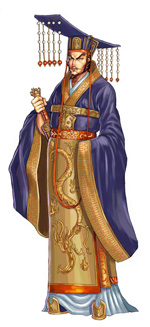 In 221 BC, after years of fighting, the state of Qin defeated the warring states that the Zhou Dynasty had in essence created, unified China and established the Qin Dynasty. The king of Qin invented the title 'Huangdi'(emperor) and called himself 'QinShihuangdi' (First Emperor). The vast territory of the Qin Empire bordered Vietnam in the south, and the Yellow Sea in the east. The most developed area was in the Yellow River Valley. The emperor abolished the aristocracies and divided the empire into provinces. He appointed officials to administer the provinces, and controlled the country with strict laws and harsh punishments.
In 221 BC, after years of fighting, the state of Qin defeated the warring states that the Zhou Dynasty had in essence created, unified China and established the Qin Dynasty. The king of Qin invented the title 'Huangdi'(emperor) and called himself 'QinShihuangdi' (First Emperor). The vast territory of the Qin Empire bordered Vietnam in the south, and the Yellow Sea in the east. The most developed area was in the Yellow River Valley. The emperor abolished the aristocracies and divided the empire into provinces. He appointed officials to administer the provinces, and controlled the country with strict laws and harsh punishments.
The first emperor not only unified China, but also standardized writing, weights, and measures throughout the kingdom. The states had previously had their own standards of measuring and weighing. Now the Qin emperor wanted his kingdom to have a standardized measurement to promote trade among the newly conquered states.
 All schools of thought, except for legalism, were abolished. In 213 BC, all the books of the opposing schools of thought were burned except for the copies preserved in the Qin imperial library. The emperor thought that the only way to keep his nation together was to have everyone think the same way. Any deviation would throw China back into the chaos of the past 100 years of war.
All schools of thought, except for legalism, were abolished. In 213 BC, all the books of the opposing schools of thought were burned except for the copies preserved in the Qin imperial library. The emperor thought that the only way to keep his nation together was to have everyone think the same way. Any deviation would throw China back into the chaos of the past 100 years of war.
In order to secure his territories and prevent nomadic invasion, the construction of the Great Wall was begun. The building exacted a massive financial toll and a great loss of life on the Chinese people. This led to the decline of the Qin Dynasty. After the emperor died, the people rebelled against his tyranny, and the dynasty was overthrown. The Qin Dynasty lasted only from 221 to 206 BC, but its influence brought great changes to China. The dynasty left the country with a great historical legacy. This is the emperor whose magnificent mausoleum contains the life-like army of Terra-cotta Warriors and Horses.

